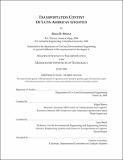| dc.contributor.advisor | Edgar Blanco. | en_US |
| dc.contributor.author | Sweat, Sean D. (Sean David) | en_US |
| dc.contributor.other | Massachusetts Institute of Technology. Dept. of Civil and Environmental Engineering. | en_US |
| dc.date.accessioned | 2008-12-11T16:57:33Z | |
| dc.date.available | 2008-12-11T16:57:33Z | |
| dc.date.copyright | 2008 | en_US |
| dc.date.issued | 2008 | en_US |
| dc.identifier.uri | http://hdl.handle.net/1721.1/43751 | |
| dc.description | Thesis (S.M.)--Massachusetts Institute of Technology, Dept. of Civil and Environmental Engineering, 2008. | en_US |
| dc.description | This electronic version was submitted by the student author. The certified thesis is available in the Institute Archives and Special Collections. | en_US |
| dc.description | Includes bibliographical references (p. 117-125). | en_US |
| dc.description.abstract | Through increasing globalization and trade liberalization, many third-world and developing countries are experiencing levels of growth that are quickly shifting the world's balance of political and economic power. China and India have dominated the global discussion of emerging economies, but other regions that have received much less attention hold attractive potential as well from the perspective of United States companies -- in particular, Latin America. Domestic companies going international for the first time or even just into a type of foreign market that is very different from previous experience can find the learning curve steep and their ce-reliable intuition no longer useful. Penetrating such a market requires a taut supply chain and while there are many facets to any supply chain, we here focus on the transportation aspect and build the Latin American context surrounding it and affecting logistical decisions and paradigms. By exploring the unsuccessful and ongoing attempts at regional integration, the policies that shape the business environment, the barriers and opportunities presented by a unique geography, and the underdeveloped infrastructure, we build the context necessary to develop a holistic understanding of Latin America and its diverse member nations. Using this context, we explore a way to compare the new environment to old experiences and to provide knowledge required to plan supply chain networks in the region. | en_US |
| dc.description.statementofresponsibility | by Sean D. Sweat. | en_US |
| dc.format.extent | 125 p. | en_US |
| dc.language.iso | eng | en_US |
| dc.publisher | Massachusetts Institute of Technology | en_US |
| dc.rights | M.I.T. theses are protected by
copyright. They may be viewed from this source for any purpose, but
reproduction or distribution in any format is prohibited without written
permission. See provided URL for inquiries about permission. | en_US |
| dc.rights.uri | http://dspace.mit.edu/handle/1721.1/7582 | en_US |
| dc.subject | Civil and Environmental Engineering. | en_US |
| dc.title | Transportation context of Latin American logistics | en_US |
| dc.type | Thesis | en_US |
| dc.description.degree | S.M. | en_US |
| dc.contributor.department | Massachusetts Institute of Technology. Department of Civil and Environmental Engineering | |
| dc.identifier.oclc | 268677443 | en_US |
